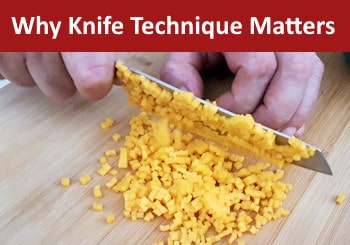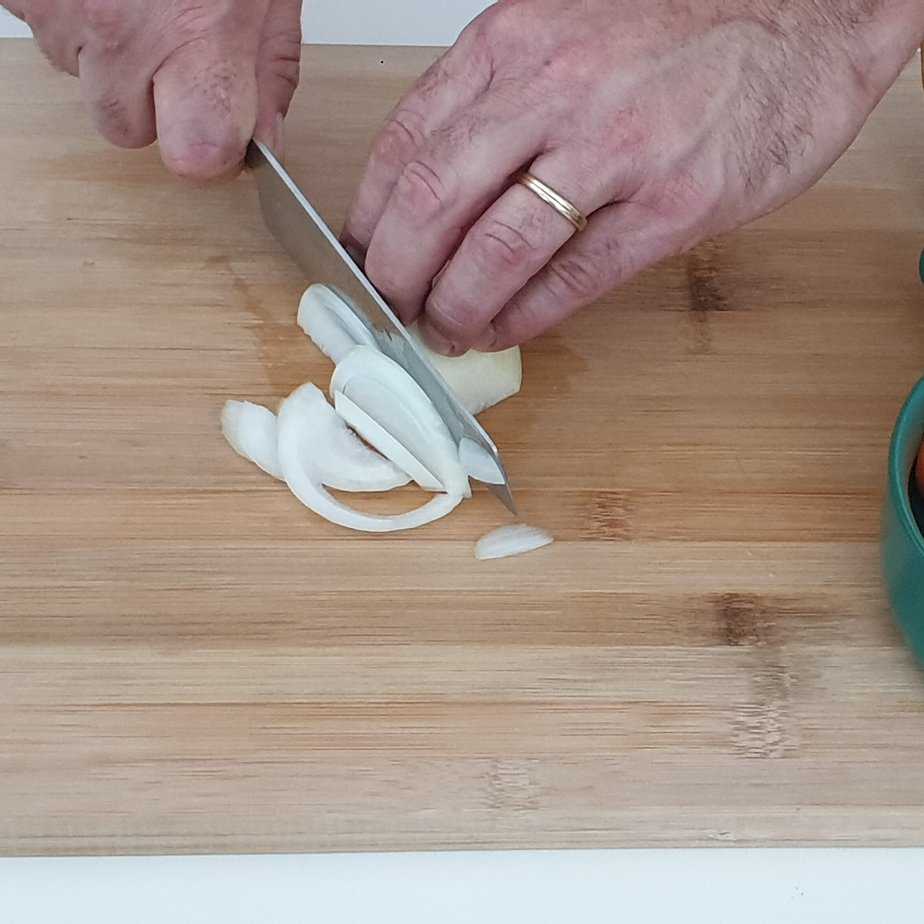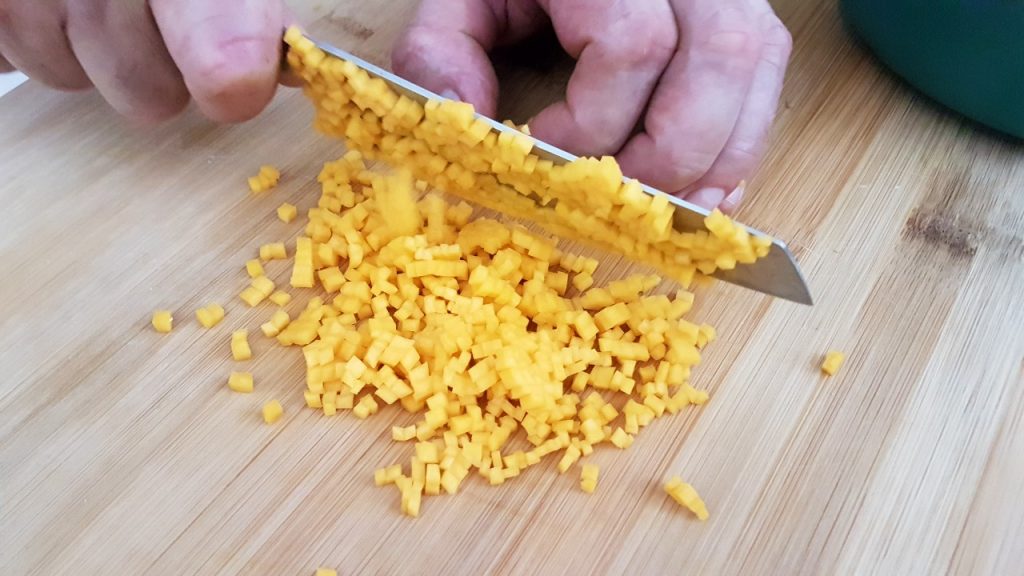Why Proper Knife Technique Matters in the Kitchen
| Mini guides to kitchen knives: Kinds of kitchen knives | Materials and construction | Storing | Sharpening | Maintaining sharpness | Rust removal | Disposal | Knife skills | Western or Japanese knives | Main kitchen knife guide |

Using quality knives is important, and mastering basic knife skills and knife technique are equally important when cooking often.
Using a sharp knife without knowing the correct procedure will not elevate your culinary skills or allow for efficient working.
Applying proper knife technique doesn’t necessarily mean speed while cutting, but handling a knife correctly is important for precision cutting or chopping finesse. Once basic skills are mastered, you can practise developing accuracy and speed.
You may also find that there are distinct differences between Japanese kitchen knives and Western kitchen knives.
Why is uniformity and consistency important in knife skills?
In any kitchen, the way you handle a knife matters just as much as the ingredients you use. Good knife skills are crucial to successful cooking. Uniformity and consistency make your prep faster, your cooking more efficient, and your food cook evenly.
It’s about making your cooking process smoother, safer, and more enjoyable. Let’s review why uniformity and consistency in knife skills are crucial.
Cooking evenness
Uniformly cut ingredients cook at the same rate. This ensures that all pieces reach the desired level of doneness simultaneously, preventing some pieces from being overcooked and others undercooked.
Presentation and aesthetics
Consistently cut ingredients enhance the visual appeal of a dish. In culinary arts, the presentation of a dish is almost as important as its taste.
In fact, in professional kitchens, presentation is a reflection of skill and attention to detail, which is important in high-end dining experiences.
Safety
Consistent knife skills reduce the risk of accidents. When you’re accustomed to cutting in a uniform manner, your movements are more controlled and predictable, decreasing the likelihood of cutting yourself.
Also, workflow is improved. Consistency in cutting technique improves efficiency, allowing for quicker preparation without sacrificing safety.
Portion control
Uniform cuts help in managing ingredient portions better, ensuring that each serving of the dish has an equal amount and mix of ingredients.
Similar to ingredient control is cost control, too. In a professional setting, consistent portion sizes are crucial for cost management and maintaining profit margins.
Culinary precision
Many recipes depend on the size and uniformity of chopped ingredients for flavour development and texture. For instance, finely diced onions will impart a different texture and possibly a different type of flavor release than roughly chopped onions.
In other words, uniformity and consistency help to manage recipe accuracy and the best outcome of the dish.
Finally, to answer the question why is uniformity and consistency important in knife skills, the most succinct answer is:
Uniformity and consistency in knife skills are not just about making food look appealing. They play a critical role in ensuring even cooking, maintaining safety, controlling portions, and achieving culinary precision.
These skills are essential for any aspiring chef and beneficial for home cooks to improve the overall quality of their cooking.
6 Points to note when improving kitchen knife skills
When we started as culinary students our very first lessons were based on knife skills and safety in the kitchen. We’ll outline exactly what we learned in culinary school, and add further tips from our many years of experience.
1. Understanding your knife
Understand the anatomy of your knife and discover how each component influences the comfortability and balance when holding, from the grip to cutting technique.
2. Safety
Control the grip and always keep your fingertips away from the knife by leaning the blade against your knuckles while keeping the food in place with your fingers. It will require practice but once used to this technique you find it easier and much safer.

3. Control and balance
Once you know how to hold a knife correctly this will minimise fatigue, and will feel more comfortable. You will have more control and be able to enhance efficiency and most probably speed, although speed is less important whilst learning.
4. Presentation and plating
Once you master great knife techniques it is easier to produce more visually appealing dishes. You can elevate meals by maintaining precise and uniform cuts
5. Improve creativity
Together with good knife skills comes an increased level of confidence and exploration of more precise and delicate culinary procedures. This creativity can lead to finer cutting jobs for garnishing plates or specific presentation, and to learning more difficult skills such as deboning pieces of meat, or filleting fish.
6. Types of knife cuts
There are some essential cuts used by chefs around the world. Here are the 4 most common types of knife cuts:

- Julienne, also known as the matchstick cut, is most commonly used for vegetables to use as a garnish or in stir-fries. The vegetables are cut in long, thin sticks of about 4-5 cm long and 2 mm thin. If the sticks are larger they can also be called batonnet.
- Brunoise consists of cutting ingredients in tiny cubes of about 1-2 mm in size. This dicing technique is usually used to add texture to soups and garnishes. Besides brunoise there are also larger cubes which are called dice.
- Paysanne, translates into country cut and is mainly used when cutting ingredients into the shape of small diamonds.
- Chiffonade is a technique whereby leafy greens are stacked or rolled into a cylinder, and sliced into thin ribbons. This technique is often used when preparing salads orfor soup garnishes.
And if you find that after some time, your knife technique isn’t what it should be, maybe you need a different kitchen knife to use. But what should you do with your knife in order to dispose of it safely? Our notes on getting rid of unwanted and broken knives will help.
Final note on why proper knife technique matters in the kitchen
Mastering proper knife technique is essential in the kitchen for four main reasons.
- It enhances safety, preventing accidents and injuries that can occur from improper handling.
- Efficient cutting techniques increase precision and uniformity in food preparation, which is vital for cooking consistency and presentation.
- Skilled knife work can save time, allowing for quicker meal preparation.
- Using knives correctly helps to preserve their sharpness, leading to longer-lasting kitchen tools.
Indeed, proper knife skills are the basis of culinary proficiency, contributing to safer, more enjoyable, and more efficient cooking experiences.